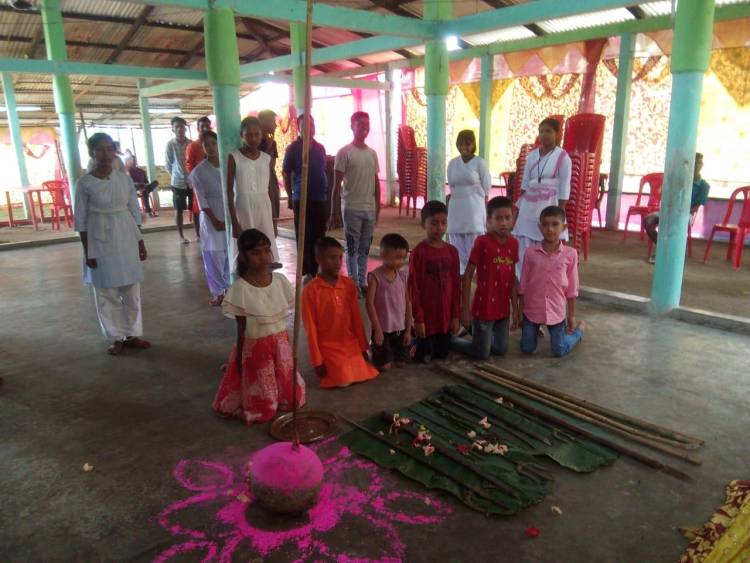[GHHF] Assam Bala Samskar Students and Tejaswini Women Group Performed Shastra or Ayudha Puja on Vijayadashami Day.
 Global Hindu Heritage Foundation is proud to inform that Bala Samskar Kendras in Assam performed Shastra Puja or Ayudha Puja on Vijayadashami Day. Bala Samskar Teachers and Tejaswini group organized this Shastra or Ayudha Puja for the students in Assam.
Global Hindu Heritage Foundation is proud to inform that Bala Samskar Kendras in Assam performed Shastra Puja or Ayudha Puja on Vijayadashami Day. Bala Samskar Teachers and Tejaswini group organized this Shastra or Ayudha Puja for the students in Assam.
On Vijayadashami Day, Hindus perform Shastra Puja, rituals that entail worshipping Shastras or weapons. According to Hindu holy books, on this day, Goddess Durga killed the demon Mahishasura after a fierce battle that lasted for nine days. Following the death of Mahishasura, the gods worshipped the weapons of Goddess Durga that she used in the battle.
According to Hindu scriptures, Bhagwan Ram performed Shastra Puja before heading to the battleground against the evil king of Lanka, Ravana, who was killed on this day. Shastra Puja has also been referred to in the Mahabharata. Legends say that weapons were worshipped before the begging of the Kurukshetra war, and they helped the Pandavas stand victorious against the Kauravas.
The rituals for Ayudha Puja involve cleaning and decorating iron tools, weapons, or instruments with flowers, turmeric, and vermilion. Depending on one's profession or daily activities, these items can range from books, musical instruments, computers, cars, and even kitchen utensils. After the tools are cleaned and adorned, they are placed in front of deities for worship, usually in a puja room or temple. Prayers are offered to ask for blessings for success and protection in their use.
Hinduism sees divinity in all of creation and God as both immanent and transcendent. Such an attitude infuses divinity into all activities of life. Work itself is worship, and this philosophy of karma yoga is yet another context in which to place the veneration of weapons. Although it means “weapons”, ayudha is also a generic term, "instrument or implement." On the ninth day of Navaratri, everyone cleans, decorates, and worships the implement that enables them to make a living, seeing a manifestation of the divine. This applies to musicians and musical instruments, farmers and the plow, students and their books, factories and machinery. And, of course, it applies to soldiers and their weapons.
It is perhaps more interesting to observe how a culture that has a tradition of worshipping weapons approaches questions of war, violence, and non-violence. Dharma, Artha, Kama, and Moksha are the four great “purusharthas” (goals of life) of Hinduism. Dharmic conduct is the basis upon which all the other goals of life are to be attained. At an individual level, it is the dharma of a soldier to fight if necessary. At a social level, the ruler must enforce dharma and protect society. Using weapons is considered part of a sacred duty to protect dharma. In our minds, this infusion of divinity and dharma into the use of firearms largely explains why a strict code of conduct circumscribed wars in India. The most crucial component of this code is that wars were fought between soldiers only, and other segments of society were not involved.
Ahimsa – peace is considered the goal of human life. Even to achieve ahimsa, you must be prepared and ready to fight with weapons. Bhishma in Anusasana Parva in Mahabharata says:
Ahimsa is the highest Dharma; Ahimsa is the highest self-control
Ahimsa is the highest charity; Ahimsa is the highest penance
Ahimsa is the highest yajna; Ahimsa is the highest strength
Ahimsa is the highest friend; Ahimsa is the highest happiness
Ahimsa is the highest truth; Ahimsa is the highest shruti.
Your donations are appreciated.
By Zelle: ghhfusaorg@gmail.com
PayPal: savetemples.org
By Check: Or you can send a check payable to GHHF, 14726 Harmony Lane, Frisco, TX 75035.
It is tax-deductible.
By Rupees: call 601-918-7111; +91 83096 43979











 Urgent support needed for Bangladesh Hindus
Urgent support needed for Bangladesh Hindus 







